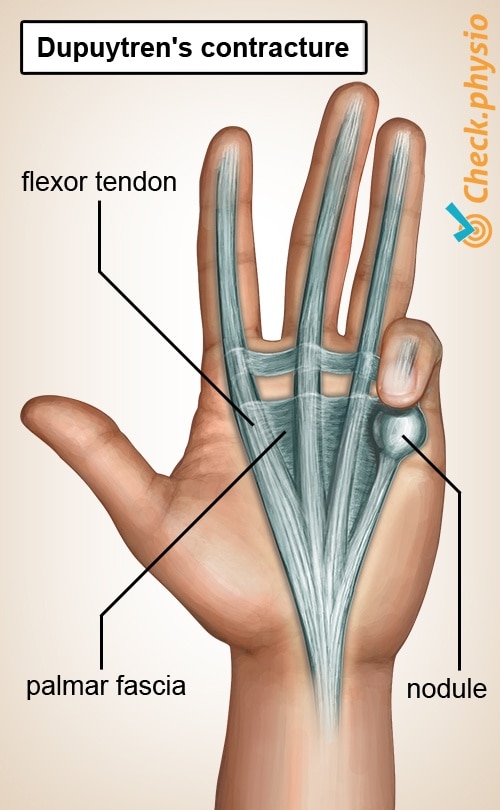Dupuytren's contracture
Dupuytren's disease/ Morbus Dupuytren / palmar fibromatosis / Viking hand
Dupuytren's contracture is characterised by the development of hard connective tissue in the palm of the hand and fingers. In the long term this can result in the fingers no longer being able to extend fully.

Description of the condition
Dupuytren's contracture causes hardening of the connective tissue in the 'palmar fascia'. This is the flat white sheath located in the hand palm around the flexor tendons running to the fingers. The hardening or lumps are called 'nodules' ('nodule' = lump).
As more and more nodules develop, they form a strand of connective tissue that contracts over time. This pulls the finger into a flexed position, making it impossible to extend. A so-called 'flexion contracture' develops.
The nodules develop between the skin and the tendons. The tendons themselves are not involved in the disease process.
The ring and little finger are often affected, but the symptoms can also occur in other fingers. The symptoms regularly occur in both hands.
Cause and origin
The symptoms develop gradually. It starts with slight hardening in the hand palm and fingers, which develops into nodules. Over the course of months or years these nodules can develop into hard subcutaneous strands of connective tissue that force the finger(s) into a flexed position.
The cause of Dupuytren's contracture is currently unknown. Inflammation, trauma, new tissue formation and genetic factors appear to play a role. Genetic predisposition is particularly prevalent in some families. There is a family history in approximately 12 % of cases.
The condition is also partially associated with diabetes mellitus. Alcoholics, smokers, patients with hypercholesterolaemia or liver problems also have a higher risk of developing Dupuytren's contracture. HIV patients and people who use anti-epileptic medication are also at increased risk.
Signs & symptoms
- Rigid strands of connective tissue and/or hard lumps in the hand palm.
- The lumps are generally not painful. However, the strands and lumps can cause pain when using the hand.
- The strands run over the palm of the hand to the fingers, usually to the ring and little finger (sometimes also to the thumb, index finger or middle finger).
- The hand palm and fingers can bend over the course of months or years. They can no longer extend.
- Stiff fingers as a result of withering of the joint capsule of the finger joints.
- In some cases a reduced sensation will be present in the fingers, because a nerve can become impinged by the connective tissue strand.
Diagnosis
There are various methods for categorisation of Dupuytren's contracture into grades. A rough categorisation is:
- Grade 1: A thickened nodule or strand of connective tissue in the hand palm.
- Grade 2: As for grade 1, with a slight limitation in extension of the finger.
- Grade 3: Advanced stage, extension of the finger is severely limited.
The curvature of the fingers is measured to gain a more accurate impression of the stage of Dupuytren's contracture.
Treatment
As the cause is unknown, treatment is aimed at combating the symptoms.
Physiotherapy
The physiotherapeutic treatment consists of stretching the contracted strands. This must take place in a controlled manner, in order to prevent extra scar formation as a result of micro trauma. A night-time splint can be used to improve the extension of the fingers.
Injections
An injection can be administered to 'soften' the tissue. The connective tissue strand is then torn off.
Percutaneous fasciotomy
A needle is used to pierce through the skin into the connective tissue strand to cleave the strand. This is performed under anaesthetic and results in minimal scar tissue formation.
Surgery
Surgery can be performed to cleave or remove the affected tissue. Surgery can greatly reduce the pain or nuisance experienced by the patient. The curvature of the fingers is corrected with this surgery. The aim of the treatment is to maintain use of the hand.
Unfortunately, for all treatments, the symptoms will return over time in many cases. Dupuytren's contracture cannot be cured.
Exercises
You can check your symptoms using the online physiotherapy check or make an appointment with a physiotherapy practice in your area.
References
Alessie, J. & Buijs, M. (2014). Bindweefsel en mobilisatie. Physios. 2014:3:6-15.
Dingemans, A.J., Sonneveld, G.J., Rappard, J.H.A. van & Borghouts, J.M.H.M. (1990). De ziekte van Dupuytren. Ned Tijdschr Geneeskd. 1990;134:2330-4.
Lohman, A.H.M. (2004). Vorm en beweging. Leerboek van het bewegingsapparaat van de mens. Houten: Bohn Stafleu van Loghum.
Nederlandse Vereniging voor Plastische Chirurgie (2012). Richtlijn. Ziekte van Dupuytren. NVPC.
Nugteren, K. van & Winkel, D. (2010). Onderzoek en behandeling van middenhand en vingers. Houten: Bohn Stafleu van Loghum.
Verhaar, J.A.N. & Linden, A.J. van der (2005). Orthopedie. Houten: Bohn Stafleu van Loghum.


